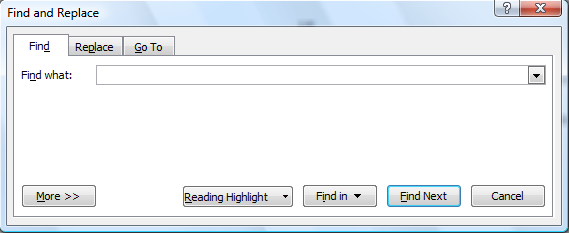Please Note: This article is written for users of the following Microsoft Word versions: 2007, 2010, 2013, 2016, 2019, 2021, and Word in Microsoft 365. If you are using an earlier version (Word 2003 or earlier), this tip may not work for you. For a version of this tip written specifically for earlier versions of Word, click here: Searching for a Specific Field.
Written by Allen Wyatt (last updated December 10, 2022)
This tip applies to Word 2007, 2010, 2013, 2016, 2019, 2021, and Word in Microsoft 365
Other issues of WordTips have featured ways in which you can search for field codes in general. You may be wondering how you can search for a specific type of field code. You can do it by following these steps in Word 2007:

Figure 1. The Find tab of the Find and Replace dialog box.
As an example, if you wanted to find a DATE field, after following steps 3 and 4, you would be searching for "^d DATE" (without the quote marks, of course).
Simple searching in Word 2010 and later versions is different than in earlier versions of Word. You can, if you desire, follow the above steps, but in place of step 2 make sure that you display the Home tab of the ribbon, click the down-arrow next to the Find tool, and then choose Advanced Find. An alternative, though, is to use the simplified Navigation pane:
Now the Navigation pane should show all matches for your desired field. Click the one that is the one you want, and Word jumps to that location in the document.
WordTips is your source for cost-effective Microsoft Word training. (Microsoft Word is the most popular word processing software in the world.) This tip (1430) applies to Microsoft Word 2007, 2010, 2013, 2016, 2019, 2021, and Word in Microsoft 365. You can find a version of this tip for the older menu interface of Word here: Searching for a Specific Field.

The First and Last Word on Word! Bestselling For Dummies author Dan Gookin puts his usual fun and friendly candor back to work to show you how to navigate Word 2019. Spend more time working and less time trying to figure it all out! Check out Word 2019 For Dummies today!
Third-party programs can be used to affect a document and change what is contained therein. Of course, getting rid of ...
Discover MoreDid you know that Word tries to keep track of who the author of a document is? This information can be easily added to ...
Discover MoreWhen you add a cross-reference to your document, it provides a way to dynamically reference text in another location, ...
Discover MoreFREE SERVICE: Get tips like this every week in WordTips, a free productivity newsletter. Enter your address and click "Subscribe."
There are currently no comments for this tip. (Be the first to leave your comment—just use the simple form above!)
Got a version of Word that uses the ribbon interface (Word 2007 or later)? This site is for you! If you use an earlier version of Word, visit our WordTips site focusing on the menu interface.
Visit the WordTips channel on YouTube
FREE SERVICE: Get tips like this every week in WordTips, a free productivity newsletter. Enter your address and click "Subscribe."
Copyright © 2025 Sharon Parq Associates, Inc.
Comments